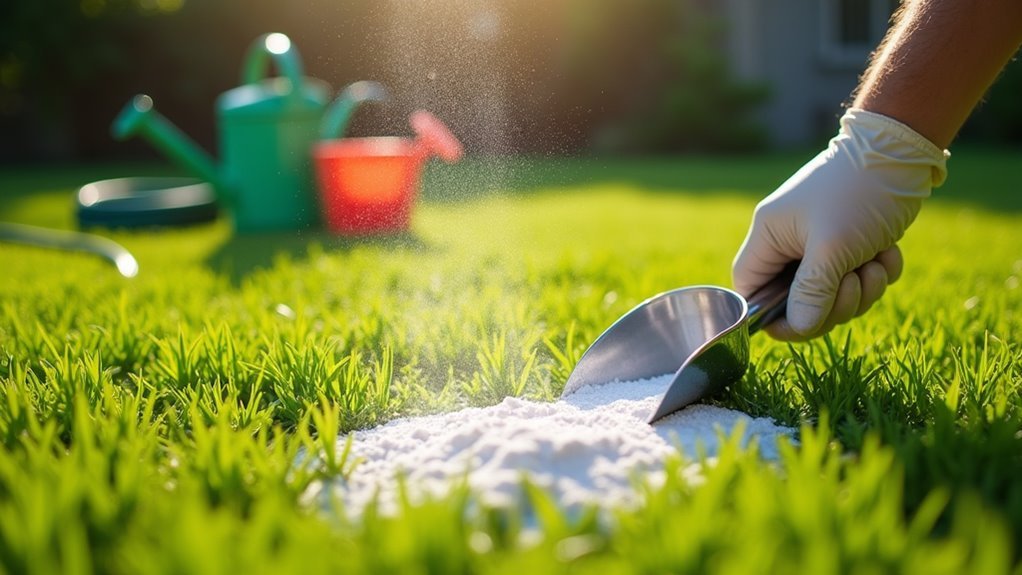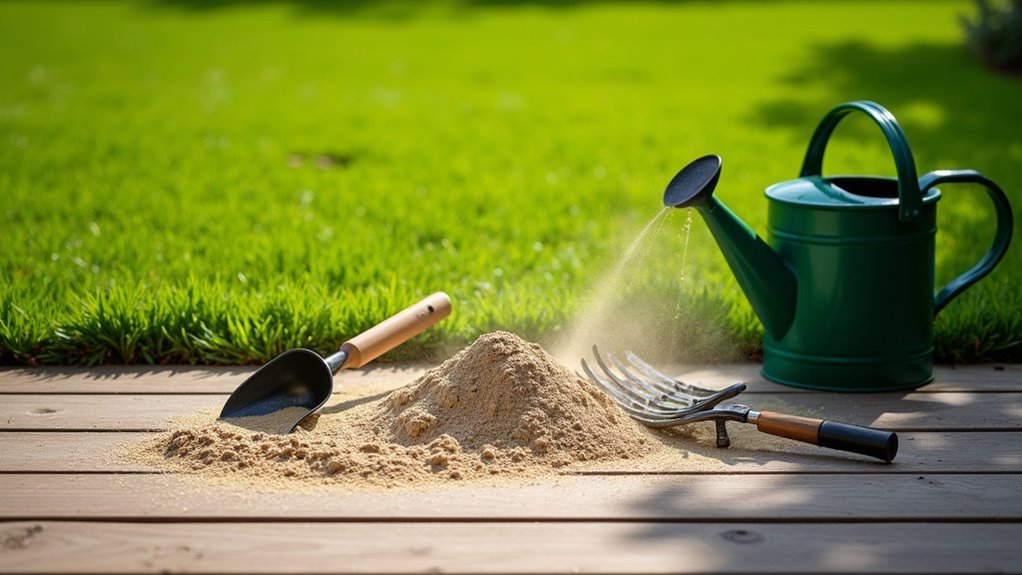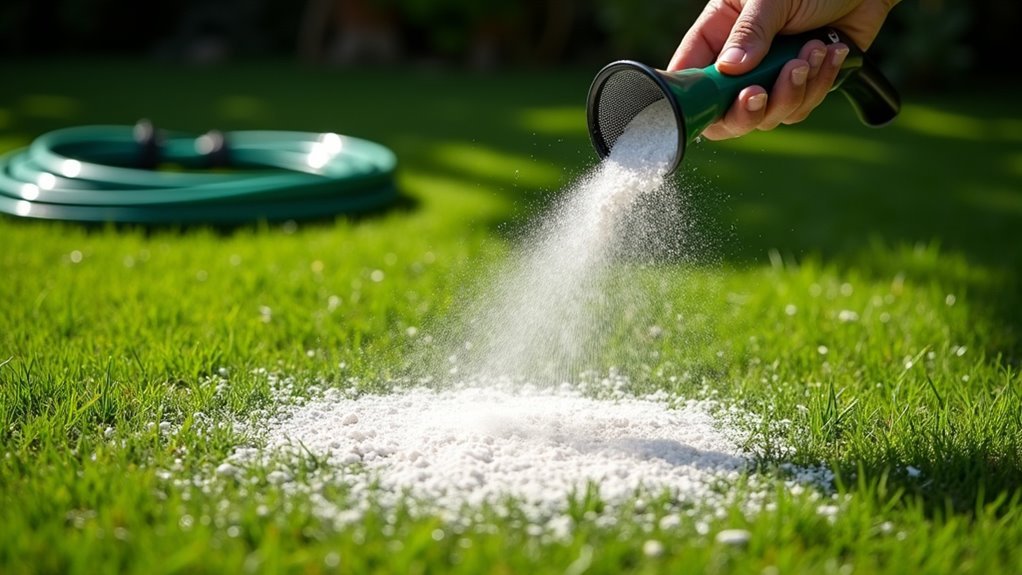You’ll need to select food-grade diatomaceous earth and prepare your lawn by mowing grass to 2-3 inches and removing debris. Apply the powder using a lawn spreader on dry, calm days, or mix it with water for wet application during early morning or evening hours. Wear protective gear including gloves, masks, and goggles throughout the process. Reapply every three days or after rain to maintain effective pest control. The complete step-by-step process involves several additional considerations.
Understanding Diatomaceous Earth and Its Benefits for Lawns

Homeowners seeking a natural solution for lawn pest problems will find diatomaceous earth an exceptional ally in their gardening arsenal. This natural insecticide comes from fossilized diatoms and offers dual benefits for your lawn care routine.
When you choose food-grade diatomaceous earth, you’re selecting a non-toxic pest control method that effectively eliminates ants, fleas, and grubs through dehydration.
Beyond pest management, the application of diatomaceous earth will improve soil health considerably. Its silica content provides essential nutrients that promote stronger grass growth while enhancing soil aeration and moisture retention.
Diatomaceous earth’s silica content strengthens grass while improving soil aeration and moisture retention for healthier lawns.
You’ll appreciate how this natural substance works without harmful chemicals, making it safe for your family and pets while delivering powerful results for both pest control and lawn health.
Choosing the Right Type of Diatomaceous Earth for Lawn Use
While you now understand the powerful benefits diatomaceous earth offers your lawn, selecting the appropriate type becomes the foundation of successful application. You must choose food-grade diatomaceous earth for lawn use, as it’s specifically designed for safe garden applications.
Unlike pool-grade varieties containing harmful chemicals, food-grade products maintain higher purity levels that effectively target pests without compromising your lawn’s health. When shopping, verify the product’s labeled as food-grade to guarantee peak pest control results.
This type eliminates fleas, ticks, and soft-bodied insects while preserving beneficial insects essential for your lawn’s ecosystem. Always review manufacturer guidelines before application, as proper selection guarantees both safety and effectiveness.
Your diatomaceous earth choice directly impacts your lawn’s long-term health and pest management success.
Essential Tools and Materials for Lawn Application

Before you begin applying diatomaceous earth to your lawn, gathering the proper tools and materials guarantees smooth, effective distribution and protects your safety throughout the process.
Essential protective gear includes gloves, a face mask, and goggles to prevent skin irritation and respiratory discomfort.
For distribution, you’ll need a lawn spreader for even coverage across large areas and a dust applicator like a flour sifter for targeting smaller spots.
If you choose wet application, prepare a watering can or hose to mix diatomaceous earth with water.
Keep a measuring cup handy for accurate mixing ratios and proper spreader loading.
Finally, have a rake or broom ready to clear debris and prepare a clean lawn surface.
Preparing Your Lawn for Diatomaceous Earth Treatment
Proper lawn preparation determines the success of your diatomaceous earth treatment, so you’ll want to start by mowing your grass to 2-3 inches in height. This shorter length guarantees better coverage when you apply diatomaceous earth across your lawn.
Next, remove all debris including leaves, sticks, and pet waste from the treatment area. Clean surfaces allow for even distribution of the fine powder throughout your lawn.
Check the weather forecast and choose a completely dry day for application. Your lawn must be moisture-free, with no rain expected for 24-48 hours.
Before handling diatomaceous earth, wear protective gear including gloves, mask, and goggles to prevent irritation.
Consider using a lawn spreader for consistent application with overlapping passes to maximize effectiveness.
Dry Application Methods for Even Distribution

The most effective dry application method involves using a lawn spreader set to its lightest setting, which distributes diatomaceous earth uniformly across your grass without creating dense patches.
You’ll want to create a fine layer that covers the entire surface area without excessive buildup. For smaller targeted areas, you can apply diatomaceous earth using a flour sifter or handheld shaker, which provides excellent control over distribution patterns.
These dry application methods work best during calm weather conditions to prevent wind dispersal. Focus on spreading diatomaceous earth evenly across problem areas where pests are most active.
Remember to reapply diatomaceous earth every few weeks or after heavy rain to maintain consistent pest control effectiveness throughout your lawn treatment program.
Wet Application Techniques for Better Adhesion
You’ll achieve better pest control results by mixing diatomaceous earth with water to create a solution that sticks firmly to plant surfaces.
The key lies in getting your mixing ratios right and timing your application when conditions favor maximum adherence and effectiveness.
This wet method works especially well when you’re targeting hard-to-reach areas where dry powder won’t stay put.
Proper Mixing Ratios
Creating an effective wet application starts with mixing 4 tablespoons of food-grade diatomaceous earth with 1 gallon of water. This precise ratio guarantees maximum coverage while maintaining the material’s pest control effectiveness.
You’ll need approximately 59 ml of diatomaceous earth per 3.8 liters of water for best results.
Mix thoroughly to prevent clumping, which reduces adhesion to plant surfaces. When you apply the solution using a spray bottle or garden sprayer, coat all surfaces evenly without creating drips.
The mixing ratios remain consistent whether treating small garden areas or larger lawn sections.
Remember to reapply after heavy rainfall or when the powder becomes less visible, maintaining the same proportions for continued effectiveness against pests.
Application Timing Tips
Timing your wet diatomaceous earth application makes the difference between success and wasted effort.
Apply diatomaceous earth during early morning or late evening when winds are calm, guaranteeing better adherence to plant surfaces. Mix four tablespoons with one gallon of water, then spray a fine layer covering all plant sides until wet but not dripping.
The mixture becomes effective when dry, so allow complete air-drying before expecting pest control results. You’ll need to reapply after rain or watering since moisture washes away the protective coating.
Always check weather forecasts before application—avoid spraying if heavy rain’s approaching within 24 hours. This timing strategy maximizes your diatomaceous earth’s staying power and guarantees consistent pest protection throughout your lawn care routine.
Optimal Timing and Weather Conditions for Application
You’ll achieve the best results when you apply diatomaceous earth during specific weather conditions and times of day.
Early morning or late evening applications work best because cooler temperatures and higher humidity help the powder stick to grass and soil surfaces.
You should also avoid windy days and plan your timing around upcoming rain to maximize effectiveness.
Best Time Selection
When moisture naturally coats your grass blades, diatomaceous earth adheres most effectively to plant surfaces and soil.
Your best option is to apply diatomaceous earth during early morning or late evening when dew provides natural stickiness for the powder.
You’ll want to avoid applying during windy conditions since the fine particles easily disperse away from target areas.
Choose application times when there’s no rain forecasted for 24-48 hours, ensuring the powder won’t wash away immediately.
After heavy rainfall or watering, you’ll need to reapply since moisture diminishes effectiveness.
Monitor environmental conditions regularly – when the powder’s no longer visible due to weather changes, plan to reapply every three days for ideal pest control results.
Weather Condition Requirements
Although environmental conditions greatly impact diatomaceous earth’s effectiveness, maintaining specific weather requirements assures maximum pest control results.
You’ll want to apply diatomaceous earth when your lawn is completely dry with no rain forecasted for 24-48 hours. This weather condition assures the powder won’t wash away immediately after application.
Avoid windy days that’ll scatter the powder unintentionally, preventing effective placement where pests actually travel.
Higher humidity levels during early morning or evening help the diatomaceous earth adhere better to grass surfaces.
You’ll need to reapply every 3 days when the powder becomes invisible or after heavy rainfall and watering sessions.
Monitor your lawn regularly since moisture diminishes the powder’s pest control capabilities, requiring fresh applications to maintain continuous protection against insects.
Reapplication Timing Guidelines
Every three days marks the critical reapplication window for diatomaceous earth when the powder becomes invisible on your lawn surface. You’ll need to reapply diatomaceous earth immediately after rain or heavy wind disrupts your protective barrier. The best application timing occurs during early morning or evening hours when dew helps the powder adhere effectively to grass and soil.
| Weather Conditions | Recommended Action | Pest Management Impact |
|---|---|---|
| Early morning dew | Apply immediately | Maximum adherence |
| Evening moisture | Ideal timing | Enhanced effectiveness |
| Windy conditions | Postpone application | Powder dispersal risk |
| Before heavy rain | Avoid application | Product waste |
| Post-storm | Reapply within 24hrs | Restore protection |
Monitor weather forecasts to avoid applying before impending storms, ensuring your pest management efforts remain cost-effective and successful.
Safety Precautions During Lawn Treatment
Before you begin applying diatomaceous earth to your lawn, you’ll need to take several important safety measures to protect yourself, your family, and your pets.
Always use food-grade diatomaceous earth, as industrial versions contain harmful additives. Wear protective gear including gloves, masks, and goggles to shield your skin and respiratory system from fine dust particles.
Food-grade diatomaceous earth is essential for safety – always wear protective gloves, masks, and goggles during application.
Work in well-ventilated outdoor areas and avoid inhaling the powder during application. Keep children and pets away from treated areas until the diatomaceous earth has completely settled and dried. This prevents accidental ingestion or inhalation of particles.
After treatment, store diatomaceous earth in a secure, locked location where children and pets can’t access it, ensuring ongoing safety for your household.
Maintenance and Reapplication Guidelines
Successful diatomaceous earth treatment requires consistent monitoring and timely reapplication to maintain its pest-controlling effectiveness.
You’ll need to reapply food-grade diatomaceous earth every three days when the powder’s no longer visible, especially after rain or heavy winds. Monitor treated areas regularly for ongoing pest activity and adjust your application frequency based on the pest reduction you observe.
Always apply during dry weather conditions for ideal adhesion and results. You must reapply after any watering or rain events to restore the protective barrier.
Clean up pet waste promptly to prevent parasite spread and enhance effectiveness. Maintaining this consistent schedule when applying diatomaceous earth guarantees continuous pest control protection throughout your treatment period.
Frequently Asked Questions
How Do You Apply Diatomaceous Earth to Your Lawn?
You’ll mow your lawn short, remove debris, then use a spreader to evenly distribute diatomaceous earth on dry grass. Wear protective gear and reapply after rain for continued pest control effectiveness.
What Are the Downsides of Diatomaceous Earth?
You’ll face respiratory risks from inhaling particles, skin irritation from overexposure, and potential harm to beneficial insects. It’s ineffective indoors, requires frequent reapplication after moisture, and doesn’t address infestation sources.
Do I Vacuum After Using Diatomaceous Earth?
You should wait 24-48 hours before vacuuming after applying diatomaceous earth. This waiting period lets it effectively work against pests. Use a HEPA filter vacuum to trap fine particles when cleaning.
Does Diatomaceous Earth Need to Be Reapplied After Rain?
Yes, you’ll need to reapply diatomaceous earth after rain since moisture washes away its effectiveness. Wait until the ground’s completely dry, then reapply every three days if heavy rainfall occurs.
In Summary
You’ve now mastered the diatomaceous earth lawn application process from start to finish. Remember to always choose food-grade DE, apply during calm weather conditions, and wear protective gear throughout the process. Whether you’re using dry or wet application methods, consistent coverage is key to success. Monitor your lawn’s response and reapply as needed. With proper timing and technique, you’ll effectively control pests while maintaining a healthy, thriving lawn naturally.





Leave a Reply